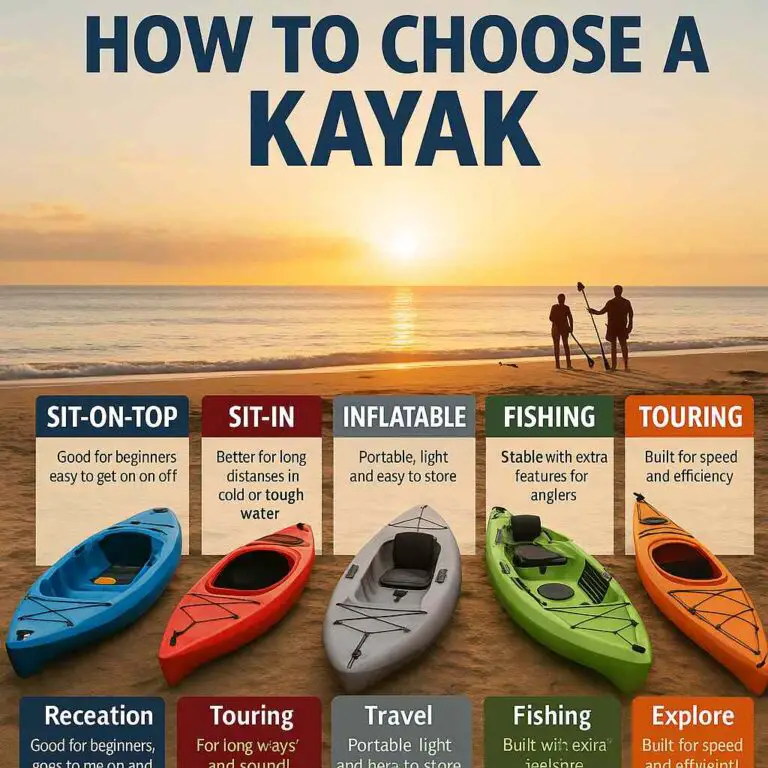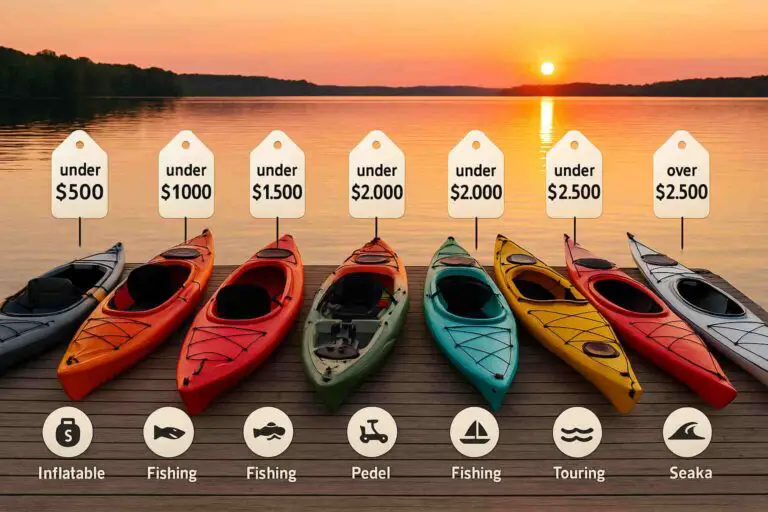Kayaking is a popular water activity enjoyed by millions of people around the world. While traditional hard-shell kayaks are the most commonly used, inflatable kayaks are also gaining popularity due to their convenience, portability, and affordability. However, many people wonder if inflatable kayaks are harder to paddle compared to hard-shell kayaks.
Inflatable kayaks are usually easy to paddle on calm waters and are great for beginners. They may not be as fast or steady as hardshell kayaks, especially in rough conditions, but they are lightweight and manageable with some practice.
In this guide, I’ll explore what impacts paddling in inflatable kayaks, debunk myths, and offer tips for smoother sailing. I’ll also suggest how to choose the right kayak and maintain it for lasting use. Whether you’re experienced or new, you’ll find valuable insights for your inflatable kayaking journey.
Understanding Inflatable Kayaks
Inflatable kayaks are boats made from durable materials that can be inflated using air to form a solid structure. They are lightweight, portable, and easy to store when deflated. There are different types of inflatable kayaks available, including sit-in kayaks, sit-on-top kayaks, and self-bailing kayaks.
Pros of Inflatable Kayaks:
- Lightweight and easy to carry
- Portable and can be transported in small spaces
- Affordable compared to hard-shell kayaks
- Easy to store when deflated
- Suitable for different types of water, including calm lakes, rivers, and whitewater rapids
Cons of Inflatable Kayaks:
- Maybe less durable than hard-shell kayaks
- Can be more challenging to navigate in windy or choppy conditions
- Paddling may require more effort due to the kayak’s flexibility
- Inflation and deflation may require additional time and effort
Overall, inflatable kayaks offer unique advantages and disadvantages compared to hard-shell kayaks. Understanding these factors can help you decide whether an inflatable kayak is the right choice for your needs.
Paddling Inflatable Kayaks: Factors to Consider
When it comes to paddling inflatable kayaks, several factors can affect the experience. Here are 5 key factors to consider:
- Kayak Design and Shape: The design and shape of the inflatable kayak can impact its performance in the water. Some inflatable kayaks have wider bases, making them more stable and easier to maneuver, while others have narrow bases for speed and agility.
- Kayak Material and Durability: The material used to make the inflatable kayak can impact its durability and resistance to punctures and tears. Look for high-quality materials such as PVC or Hypalon, which can withstand rough conditions.
- Inflation Pressure and Firmness: Inflatable kayaks require proper inflation to achieve optimal performance. Over or under-inflating the kayak can affect its stability and maneuverability. Follow the manufacturer’s recommendations for proper inflation pressure and firmness.
- Kayak Weight and Stability: The weight of the kayak can affect how easily it can be paddled. Lightweight kayaks may be easier to transport and handle but may be less stable in the water. On the other hand, heavier kayaks can be more stable but may require more effort to paddle.
- Paddling Techniques and Skills: Paddling inflatable kayaks requires different techniques compared to hard-shell kayaks. Understanding the proper paddling techniques and skills can help you navigate through the water with ease.
Are Inflatable Kayaks Hard to Paddle?
The answer to whether inflatable kayaks are hard to paddle is not a simple one. Inflatable kayaks can be slightly more challenging to paddle compared to hard-shell kayaks, but the difficulty can vary depending on several factors. The design and shape of the kayak, the material and durability, inflation pressure and firmness, and the paddler’s skills all play a role in how easy or hard it is to paddle an inflatable kayak.
However, with proper selection, inflation, and paddling techniques, it is possible to enjoy a comfortable and enjoyable paddling experience with an inflatable kayak. While inflatable kayaks may not be as durable as hard-shell kayaks, high-quality inflatable kayaks made from sturdy materials can withstand rough conditions. Therefore, it is important to choose the right type of inflatable kayak that suits your intended use, properly inflate it, and use the proper paddling techniques for optimal performance.
Let’s break down the detail!
Factors that can make inflatable kayaks harder to paddle
- Inflatable kayaks are generally more flexible than hard-shell kayaks, which can affect their maneuverability in windy or choppy conditions.
- Inflatable kayaks may require more effort to paddle due to their lightweight design, especially when facing strong currents or waves.
- Cheaper inflatable kayaks may be less stable and harder to paddle than higher-end models, affecting the overall paddling experience.
Common misconceptions about inflatable kayaks
- Inflatable kayaks are not as durable as hard-shell kayaks: While inflatable kayaks may not be as durable as hard-shell kayaks, high-quality inflatable kayaks made from sturdy materials can withstand rough conditions.
- Inflatable kayaks are not suitable for serious kayaking: Inflatable kayaks are suitable for a range of kayaking experiences, from leisurely paddles on calm lakes to more adventurous whitewater kayaking.
- Inflatable kayaks are less safe than hard-shell kayaks: Inflatable kayaks can be safe when used correctly and in suitable conditions. As with any water activity, it’s important to follow safety guidelines and wear appropriate safety gear.
Tips for easier paddling in inflatable kayaks
- Properly inflate the kayak according to the manufacturer’s recommendations for optimal performance.
- Use proper paddling techniques and adjust your stroke according to the kayak’s flexibility and maneuverability.
- Choose an inflatable kayak with a wider base for more stability, especially if you’re a beginner.
- Consider the weight of the kayak and your own physical capabilities when selecting an inflatable kayak.
- Practice in calm conditions before attempting more challenging paddling experiences.
In summary, inflatable kayaks may be slightly harder to paddle than hard-shell kayaks, but the experience can vary depending on several factors.
Choosing the Right Inflatable Kayak for Your Needs
When selecting an inflatable kayak, it’s essential to consider your needs and preferences to find the right one. Here are 6 factors to consider when choosing the right inflatable kayak for your needs:
- Kayak Type: Decide on the type of inflatable kayak that suits your intended use. Sit-in kayaks offer more protection from the elements and are more suitable for colder conditions, while sit-on-top kayaks provide more comfort in warm conditions. Self-bailing kayaks are ideal for whitewater paddling.
- Kayak Size: Consider the kayak’s size, including its length and width, to ensure it accommodates your body size and weight. Longer kayaks are faster but less maneuverable, while shorter kayaks are more agile and easier to maneuver.
- Kayak Weight: Consider the kayak’s weight, especially if you plan to carry it long distances or transport it in a vehicle. Lightweight kayaks are easier to transport and handle but may be less stable.
- Material Quality: Choose an inflatable kayak made from high-quality materials such as PVC or Hypalon, which are more durable and resistant to punctures and tears.
- Inflation and Deflation: Consider the ease of inflation and deflation, including the type of valve and the amount of time required. Some kayaks come with manual pumps, while others require an electric pump.
- Price: Consider your budget when selecting an inflatable kayak. While cheaper models may be tempting, they may not offer the same durability and performance as higher-end models.
Popular inflatable kayak brands and models to consider:
- Advanced Elements
- Sea Eagle
- Intex
- Aquaglide
- Airhead
By considering these factors and researching different brands and models, you can find the right inflatable kayak for your needs and enjoy a comfortable and enjoyable paddling experience.
Maintenance and Storage of Inflatable Kayaks
Proper maintenance and storage of inflatable kayaks can prolong their lifespan and ensure optimal performance. Here are 5 tips for maintaining and storing your inflatable kayak:
- Cleaning: After each use, rinse your kayak with fresh water to remove any dirt, sand, or debris. Use a mild soap and a soft brush to scrub away any stubborn stains. Avoid using harsh chemicals or abrasive cleaning tools that can damage the kayak’s material.
- Drying: Thoroughly dry your kayak before storing it to prevent mold or mildew growth. You can air dry it in the sun or use a towel to remove excess water. Ensure that all the seams and crevices are completely dry before packing it away.
- Storage: Store your kayak in a cool, dry place away from direct sunlight or heat sources. Avoid storing it in an area where it can be punctured or damaged. Use the manufacturer’s storage bag or a similar protective cover to prevent dust and debris from accumulating.
- Repairing: If your kayak sustains any damages or punctures, repair them as soon as possible to prevent further damage. Use a repair kit designed for inflatable kayaks and follow the manufacturer’s instructions carefully.
- Inflation: Do not overinflate your kayak as it can cause the seams and material to stretch and weaken. Use a pressure gauge to ensure that the kayak is properly inflated to the manufacturer’s recommended pressure.
You might wonder if you can leave your inflatable kayak inflated, find your answer here.
Conclusion
Inflatable kayaks offer many benefits to paddlers, including portability, affordability, and convenience. While they may be slightly harder to paddle compared to hard-shell kayaks, choosing the right inflatable kayak, properly inflating it, and using proper paddling techniques can improve your experience on the water.
Consider factors such as kayak design and shape, material and durability, inflation pressure and firmness, kayak weight and stability, and your own paddling skills when selecting an inflatable kayak. Proper maintenance and storage practices can also prolong the kayak’s lifespan and ensure optimal performance. Whether you’re a beginner or an experienced paddler, inflatable kayaks can provide a fun and enjoyable way to explore the waters.








